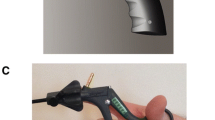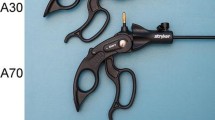Abstract
Background
The ergonomic deficiencies of currently available minimally invasive surgery (MIS) instrument handles have been addressed in many studies. In this study, a new ergonomic pistol handle concept, realized as a prototype, and two disposable ring handles were investigated according to ergonomic properties set by new European standards.
Methods
In this study, 25 volunteers performed four practical tasks to evaluate the ergonomics of the handles used in standard operating procedures (e.g., measuring a suture and cutting to length, precise maneuvering and targeting, and dissection of a gallbladder). Moreover, 20 participants underwent electromyography (EMG) tests to measure the muscle strain they experienced while carrying out the basic functions (grasp, rotate, and maneuver) in the x, y, and z axes. The data measured included the number of errors, the time required for task completion, perception of pressure areas, and EMG data. The values for usability in the test were effectiveness, efficiency, and user satisfaction. Surveys relating to the subjective rating were completed after each task for each of the three handles tested.
Results
Each handle except the new prototype caused pressure areas and pain. Extreme differences in muscle strain could not be observed for any of the three handles. Experienced surgeons worked more quickly with the prototype when measuring and cutting a suture (~20%) and during precise maneuvering and targeting (~20%). On the other hand, they completed the dissection task faster with the handle manufactured by Ethicon. Fewer errors were made with the prototype in dissection of the gallbladder. In contrast to the handles available on the market, the prototype was always rated as positive by the volunteers in the subjective surveys.
Conclusions
None of the handles could fulfil all of the requirements with top scores. Each handle had its advantages and disadvantages. In contrast to the ring handles, the volunteers could fulfil most of the tasks more efficiently using the prototype handle without any remarkable pressure areas, cramps, or pain.
















Similar content being viewed by others
Notes
MDD, the Medical Device Directive 2007/47/EG
References
Berguer R, Gerber S, Kilpatrik G, Beckley D (1998) An ergonomic comparison of inline versus pistol-grip handle configuration in a laparoscopic grasper. Surg Endosc 12:805–808
Berguer R, Gerber S, Kilpatrick G, Remler M, Beckley D (1999) A comparison of forearm and thumb muscle electromyographic responses to the use of laparoscopic instruments with either a finger grasp or a palm grasp. Ergonomics 42:1634–1645
Berguer R, Forkey DL, Smith DW (2001) The effect of laparoscopic instrument working angle on surgeons’ upper extremity workload. Surg Endosc 15:1027–1029
Delagi EF, Iazetti J, Perotto A, Morrison D (1989) Elektromyographie der Extremitäten Ferdinand Enke. Verlag, Stuttgart, Germany
Emam TA, Frank TG, Hanna GB, Stockham G, Cuschieri A (1999) Rocker handle for endoscopic needle drivers: technical and ergonomic evaluation by infrared motion analysis. Surg Endosc 13:658–661
Emam TA, Frank TG, Hanna GB, Cuschieri A (2001) Influence of handle design on the surgeon’s upper limb movements, muscle recruitment, and fatigue during endoscopic suturing. Surg Endosc 15:667–672
EN IEC 62366-Ed. 1.0–medical devices (2007) Application of usability engineering to medical devices. IEC Geneva, Beuth Verlag, Berlin
Hanna GB, Shimi S, Cuschieri A (1997) Optimal port locations for endoscopic intracorporal knotting. Surg Endosc 11:397–401
Horgan LF, O’Riordan DC, Doctor N (1997) Neurapraxia following laparoscopic procedures: an occupational hazard. Min Invas Ther Allied Technol 6:33–35
ISO/IEC 25062 (2006) Software engineering: software product quality requirements and evaluation (SQuaRE): common industry format (CIF) for usability test reports. Beuth Verlag, Berlin
Kano N, Kasugai H, Yamakawa T (1993) Laparoscopic surgeon’s thumb. Arch Surg 128:1172
Lewis JR (1991) Psychometric evaluation of an after-scenario questionnaire for computer usability studies. IGCHI Bull 23:78–81
Lotz JC (1997) The suffering surgeon. Surg Endosc 11:548
Majeed AW, Jacob G, Reed MW, Johnson AG (1993) Laparoscopist’s thumb: an occupational hazard? Arch Surg 128:357
Matern U, Koneczny S (2006) Ergebnisse der Umfrage zu den Arbeitsbedingungen im OP auf dem Deutschen Chirurgenkongress 2004. Zentralbl Chir 131:393–400
Matern U, Waller P (1999) Instruments for minimally invasive surgery: principles of ergonomic handles. Surg Endosc 13:174–182
Matern U, Waller P, Eichenlaub M, Rückauer KD (1999) MIS instruments: an experimental comparison of various laparoscopic handles and their design. Surg Endosc 13:756–762
Matern U, Giebmeyer C, Bergmann R, Faist M (2001) Ergonomic aspects of different handles for minimally invasive surgery: an EMG-based study. Proceedings of the human factors and ergonomics society 45th annual meeting, pp 1269–1273
Matern U, Waller P, Giebmeyer C, Rückauer KD, Farthmann EH (2001) Ergonomics: requirements for adjusting the height of laparoscopic operating tables. JSLS 5:7–12
Matern U, Giebmeyer C, Bergmann R, Waller P, Faist M (2002) Ergonomic aspects of four different types of laparoscopic instrument handles with respect to elbow angle: an EMG-based study. Surg Endosc 16:1528–1532
Matern U, Kuttler G, Giebmeyer C, Waller P, Faist M (2004) Ergonomic aspects of five different types of laparoscopic instrument handles under dynamic conditions with respect to specific laparoscopic tasks: an electromyographic-based study. Surg Endosc 18:1231–1241
Melzer A (1996) Endoscopic instruments: conventional and intelligent. In: Touli J, Hunter J, Gossot D (eds) Endosurgery. Churchill Livingstone, New York, pp 69–95
Mueller LP (1993) Laparoscopic instrument grips: an ergonomic approach. Surg Endosc 7:465–466
Patkin M (1997) A checklist for handle design. Ergonom Australia 11(2). http://www.uq.edu.au/eaol/Apr97/handle.html. Accessed 7 June 2003
Quick NE, Gillette JC, Shapiro R, Adrales GL, Park AE (2003) The effect using laparoscopic instruments on muscle activation patterns during minimally invasive surgical training procedures. Surg Endosc 17:462–465
Van der Zee DC, Bax NMA (1995) Digital nerve compression due to laparoscopic surgery. Surg Endosc 9(6):740
Van Veelen MA, Meijer DW, Goossens RHM, Snijders CJ (2001) New ergonomic criteria for handles of laparoscopic dissection forceps. J Laparoendosc Adv Surg Tech 11:17–26
Van Veelen MA, Meijer DW, Goossens RHM, Snijders CJ, Jakimowicz JJ (2002) Improved usability of a new handle design for laparoscopic dissection forceps. Surg Endosc 16:201–207
Zipp P (1982) Recommendations for the standardization of lead positions in surface electromyography. Eur J Appl Physiol 50:35–40
Acknowledgment
We thank Prof. C. D. Claussen, MD (University Hospital of Tübingen, Germany), for his support during this study and for his review of this article.
Disclosures
D. Büchel, R. Mårvik, B. Hallabrin and U. Matern have no conflicts of interest or financial ties to disclose.
Author information
Authors and Affiliations
Corresponding author
Rights and permissions
About this article
Cite this article
Büchel, D., Mårvik, R., Hallabrin, B. et al. Ergonomics of disposable handles for minimally invasive surgery. Surg Endosc 24, 992–1004 (2010). https://doi.org/10.1007/s00464-009-0714-x
Received:
Accepted:
Published:
Issue Date:
DOI: https://doi.org/10.1007/s00464-009-0714-x




